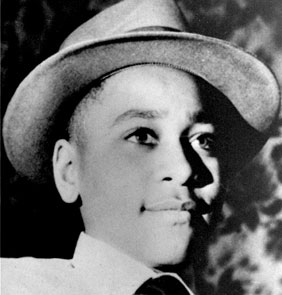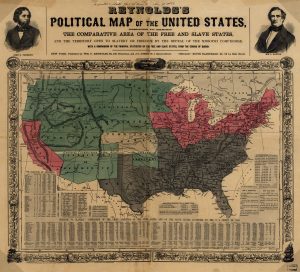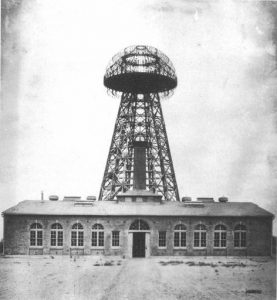Imagine sending your son to visit relatives, thinking you would see him again in a few weeks, only to learn two weeks later that he was murdered. Emmett Louis Till was born in Chicago, Illinois on July 25, 1941 to working class parents.1 His parents, both from the south, met in Argo, Illinois.2 Emmett sadly grew up without his father, after the Army executed him for raping two women and murdering a third in Italy. To add to this already hard life, Emmett got polio at a young age. Although he survived, he was left with a stutter. At school he was known as risk-taker, and he was also described as very outgoing. During the summer of 1955, Emmett’s mother sent him when he was only fourteen years old to Mississippi to visit some relatives, not knowing that she would never see her son alive again.3
Life in the south was much different than life was like where Emmett was from. He did not act the same way his cousins did around white storeowners. He talked freely about his girlfriend back home who was a white woman. One night, after a week in Mississippi, Emmett and seven other teenagers drove to a nearby town to hang out. While they were there, they went to the local grocery store owned by a white couple, Roy and Carolyn Bryant. Roy Bryant was away on a trip, and Carolyn was left in charge of the store. Several accounts exist of the events that happened next, but what is thought to have happened is the boys dared Emmett to go inside the store and ask Carolyn Bryant on a date. It is said that he went inside, bought a pack of gum, then grabbed her hand and asked her on a date. Immediately after this, she pulled away and ran into the back of the store to get a gun. During the time where she went into the back, Emmett’s cousins, realizing what had just happened, ran into the store and pulled Emmett out. As the teenagers were leaving, Emmett allegedly whistled at her and possibly even said, “bye baby!”4

After returning from his trip and finding out what had happened, Roy Bryant and his half-brother J.W. Milam went out to seek revenge. They arrived at the house of Moses Wright, Emmett’s uncle, late Saturday night, both armed with pistols. They stormed the house, ripped Emmett out from his bed, and drove off with him. His uncle pled with them, explaining Emmett was from the north and didn’t know any better, but the men refused to listen. They drove to Milam’s home where they tortured Emmett and mutilated his body. Then they took him to the Tallahatchie River where they forced him to take off all his clothes, shot him, then tied a metal fan to his body and rolled it into the river. Wright reported the kidnapping to the local sheriff the next morning, and by noon, police arrested the two men. They confessed to kidnapping him but claimed that they had let him go. Three days later, fishermen found Emmett’s body floating in the river.5
Mamie Till insisted on having Emmett’s body returned to Chicago so that she could have a funeral for him. She had an open-casket funeral so that everyone would see what had been done to her son. News of this spread immediately and caused an outbreak of protests. In Harlem, an estimated 20,000 people rallied to demand that Congress pass an anti-lynching bill.6
The trial of Roy Bryant and J.W. Milam began on September 19, 1955. Because African-Americans, and women were not allowed to serve as jurors in Mississippi, the jury was all white and all male. After four days of testimony, the jury acquitted Bryant and Milam of all charges. The two later confessed to the murder in an interview, but because of double jeopardy they were not able to be prosecuted.7
Following the news of the trial, thousands of outraged people spoke out. People began to realize that even after Brown v. Board of Education, there was still so much more that needed to be done. Citizens sent letters to their congressmen and the White House, newspapers editorials bashed the jury’s decision, and the number of people in the NAACP expanded greatly. Mamie Till spoke out on multiple occasions about the injustice that her son received. She told people to remember what happened to him and to continue fighting for justice. In addition, popular artists at the time including Gwendolyn Brooks, Toni Morrison, James Baldwin, and Bob Dylan used their own talents to create works dedicated to the Emmett and his case.8
In 2004, the FBI reopened the case. This investigation lasted three years, and during it they exhumed Till’s body to do a complete autopsy. The autopsy did not lead to any criminal charges, but it did lead to Milam’s brother confessing on his deathbed about his own involvement in the kidnapping. Till’s body was put in a new casket and his old casket was later donated to the Smithsonian’s National Museum of African American History and Culture.9
In 2008, a bill was signed into law called the Emmett Till Unsolved Civil Rights Crime Act, which provided funding to “reinvestigate crimes against civil rights workers and their allies.”10 Till’s name continues to remain in our nation’s memory, specifically through the statue of him and Dr. Martin Luther King, Jr. in Denver’s City Park, and in the Emmett Till Players that his mother formed in Chicago. Even today, his case is still being looked at. It was reopened in 2018 due to the publication of a book containing a confession from Carolyn Bryant that states she lied in her testimony during the trial.11 Even though the men who did this to Emmett Till got away with it, the nation is still fighting to get him the justice he deserves. No matter how long ago something occurred, it is never too late to seek justice.
- Encyclopedia Britannica, 2018, s.v. “Emmett Till,” by Michael Ray. ↵
- Simeon Wright and Herb Boyd, Simeon’s Story: An Eyewitness Account of the Kidnapping of Emmett Till (Chicago: Chicago Review Press, 2010), 14. ↵
- James J. Podesta, “Till, Emmett 1941-1955,” Contemporary Black Biography 7 (1994): 262-266. ↵
- James J. Podesta, “Till, Emmett 1941-1955,” Contemporary Black Biography 7 (1994): 262-266. ↵
- James J. Podesta, “Till, Emmett 1941-1955,” Contemporary Black Biography 7 (1994): 262-266. ↵
- James J. Podesta, “Till, Emmett 1941-1955,” Contemporary Black Biography 7 (1994): 262-266. ↵
- Encyclopedia Britannica, 2018, s.v. “Emmett Till,” by Michael Ray. ↵
- Salem Press Biological Encyclopedia, 2014, s.v. “Emmett Till,” by Catherine R Squires. ↵
- Encyclopedia Britannica, 2018, s.v. “Emmett Till,” by Michael Ray. ↵
- Salem Press Biological Encyclopedia, 2014, s.v. “Emmett Till,” by Catherine R Squires. ↵
- Salem Press Biological Encyclopedia, 2014, s.v. “Emmett Till,” by Catherine R Squires. ↵



49 comments
Mohammed Hani Shaik
I understand revenge but this is nowhere close to anything that can be deemed revenge! Truly I can’t think of a possible reason why the men would mutilate and kill a young boy like that. It broke my heart to see his fate however, I am happy to see that it spurred some response from the public and that Individuals are still seeking justice for him. Incredibly well written article!
Michael Thompson
The fact that the mother was a heavy activist is amazing, using her son’s death in a positive way, even though the whole situation in reality is awful. I mean the statement of the open casket even with the mutilated state speaks hugely. It’s good that the case is finally getting recognized, and that the record shows his death was a senseless murder and nothing less. But this case was huge for American history, for sure.
Courtney Pena
I remember learning about this in high school. It is unfortunate that the White men were not found guilty for murdering Till over him whistling at a White woman. I remember Till’s mother wanting to have his casket open so that people could see the harm that the White men did to her son. This was impactful because it led to protests. Eventually, the Emmett Till Unsolved Civil Rights Crime Act was passed in 2008 which provided funding to reinvestigate crimes against civil rights workers.
Nelly Perez
It is sad to hear that Emmett had to get injured just because he whistled at Mrs. Bryant and asked her on a date as a dare. She should not have freaked out about it or at least, lie in her testimony since she was seen as the victim. The men who took Emmett still should have gotten some sort of punishment instead of just getting away with the crime. They basically assaulted a child just because he hit on his wife. At least his case sparked a revolution for justice and equality among blacks and whites.
Kaleb Werku
Wow, it crazy to think this was just half a century ago. It is greatly disturbing that these evil men got away with murder, I can’t process how they weren’t found guilty I know the system was racist but when a case like this gets presented and the mutilation that occurred I would think that the jury would convict him but I guess the hate was too great.
Patricia Arechiga
I remember watching a documentary that brought up the on Emmett Till. Reading this and remembering the images and tapes I saw about this case continues to bring a great amount of sadness. I find it beyond disgusting that these men got away with the murder. United States history is filled with nothing but disgust. The fact that the jury consisted of nothing but white men brings rage to me. We do not know exactly what happened that day and knowing that the wife lied during the trial just causes the rise of many more questions regarding the case overall. I am so glad that the case was reopened. This poor boy was just a boy from the north who wasn’t aware or accustomed to the southern part of the countries ways.
Kathryn Martinez
Majority of our grandparents are still alive and were around during the time this case took place. It is insane how much life has changed over a time period of 60 years. But it truly goes to show that we cannot bury our history or these types of cases would rise again. Now you see couples of various backgrounds, something which seemed impossible back then and has now become the norm.
Cristianna Tovar
I remember hearing about Emmett Till’s story in high school, and it’s just as heartbreaking reading about it now. Emmett was just doing what he thought was a harmless dare, and he was just trying to have fun with his cousins. However, he paid the ultimate price when he was murdered by two grown, white men. The fact that there was a confession by Carolyn Bryant stating that she had lied in her testimony makes me so angry because none of what happened would’ve occurred if she just told the truth. I am glad, however, that we are still actively seeking justice for Emmett Till.
Thalia Romo
It’s crazy to think that this happened nearly 60 years ago. The fact that white individuals were so malicious to African-American’s is so unbelievable. As well as how insane the ruling were in the court case against Roy Bryant and JW Milam; An all-white, all-male jury just sounds intimidated and unjust for that time period. It terrible what happened to Emmett Till, but I’m glad there are still individuals who are fighting for him and continuing his life through monuments and historical museums.
Thalia Romo
malicious to African-American’s is so unbelievable. As well as how insane the ruling were in the court case against Roy Bryant and JW Milam; An all-white, all-male jury just sounds intimidated and unjust for that time period. It terrible what happened to Emmett Till, but I’m glad there are still individuals who are fighting for him and continuing his life through monuments and historical museums.